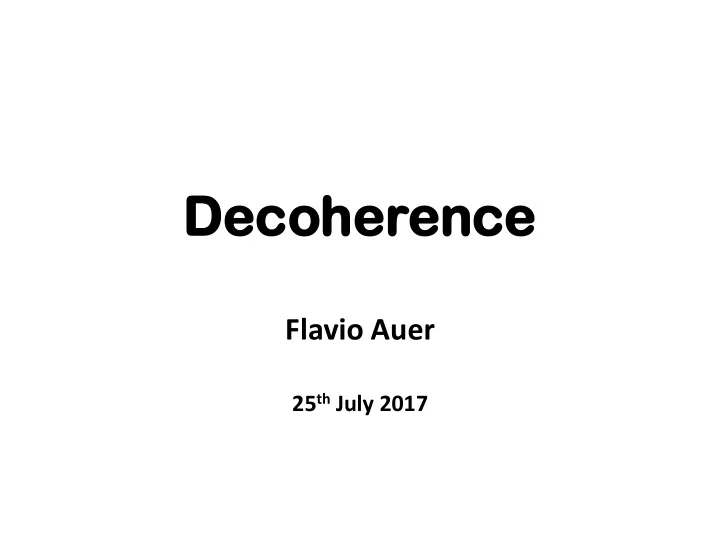

De Deco coher herence ence Flavio Auer 25 th July 2017
World is Quantum! ↓ Why does it look classical? → Decoherence
Overview 1. Superposition and Interference 2. Entanglement 3. Density Matrices 4. Von Neumann Measurements 5. Environmental Monitoring and Damping of Interference 6. Einselection 7. Application to the Measurement Problem Bibliography
1.1 Superpositions Superposition Principle: Linear combinations of states correspond to new quantum states. |ψ = 𝑑 𝑜 |ψ 𝑜 𝑜 1 2 particle with states |0 , |1 Example: spin- 1 → superposition: |ψ = 2 (|0 + |1 )
1.2 Interference Double-slit experiment with electrons: 1 wikimedia.org at slits: |ψ = 2 (|ψ 1 + |ψ 2 ) density at screen: 𝜍 𝑦 = 1 2 ψ 1 + ψ 2 2 = 1 2 ψ 1 2 + 1 2 ψ 2 2 + 1 2 (ψ ∗ 1 ψ 2 + ψ 1 ψ ∗ 2 ) interference terms
2. Entanglement Combine two systems A and B with Hilbert spaces ℋ 𝐵 and ℋ 𝐶 : 1) direct product state: |ψ 𝐵𝐶 = |0 𝐵 ⊗ |0 𝐶 ≡ |0 𝐵 |0 𝐶 1 2) entangled state: |ψ 𝐵𝐶 = 2 (|0 𝐵 |0 𝐶 + |1 𝐵 |1 𝐶 ) (cannot be factorised)
3. Density Matrices • single state: 𝜍 = |ψ ψ| • superposition |ψ = 𝑑 𝑜 |ψ 𝑜 : 𝑜 = |ψ ψ| = 𝑑 𝑜 𝑑 𝑛 | ψ 𝑜 ψ 𝑛 | 𝜍 𝑜,𝑛 off-diagonal terms: interference terms • mixed states: 𝜍 = 𝑞 𝑗 | ψ 𝑗 ψ 𝑗 | 𝑗 • reduced density matrix: 𝜍 𝐵 ≔ 𝑢𝑠 𝐶 𝜍
4. Von Neumann measurements • system S with states |0 , |1 • detector D with states |𝑒 0 , |𝑒 1 initially: |ψ 𝑗 𝑇 = 𝛽|0 + 𝛾|1 ; |ψ 𝑗 𝐸 = |𝑒 𝑠 → composite system: |Φ 𝑗 = |ψ 𝑗 𝑇 |ψ 𝑗 𝐸 = (𝛽|0 + 𝛾|1 )|𝑒 𝑠 interaction: |Φ 𝑔 = α|0 |d 0 + β|1 |d 1 (entangled)
5.1 Environmental Monitoring Schlosshauer (2008) Scattering of photons, air molecules etc. leads to coupling between system ( ψ ) and environment ( E ): 1 initially: |ψ |𝐹 0 = 2 (|ψ 1 + |ψ 2 ) |𝐹 0 1 2 (|ψ 1 |𝐹 1 + |ψ 2 |𝐹 2 ) → von Neumann evolution:
5.2 Damping of Interference 1 (|ψ 1 |𝐹 1 + |ψ 2 |𝐹 2 ) 2 → reduced density matrix: 1 2 (|ψ 1 ψ 1 | + |ψ 2 ψ 2 | + |ψ 1 ψ 2 | 𝐹 2 |𝐹 1 + |ψ 2 ψ 1 | 𝐹 1 |𝐹 2 ) 𝜍 = interference terms If the environment has recorded sufficient information, |𝐹 1 and |𝐹 2 will be approximately orthogonal, i.e. 𝐹 1 |𝐹 2 ≈ 0 . 1 2 (|ψ 1 ψ 1 | + |ψ 2 ψ 2 |) → interference is suppressed: 𝜍 ≈
6. Einselection (Environment-Induced Superselection) Problem of Preferred Basis: Basis of von Neumann measurement is arbitrary. What singles out the states |ψ 1 and |ψ 2 as those between which interference is suppressed? Solution: Environment-Induced Superselection The preferred states of the system emerge dynamically as those states that are most robust to interaction with the environment and thus immune to decoherence.
7. Application to the Measurement Problem Aspects of the Measurement Problem (Schlosshauer 2008): • Problem of Preferred Basis → einselection • Problem of the Nonobservability of Interference → environmental monitoring • Problem of outcomes → decoherence can explain why there are definit outcomes, ..........but not which ones
Bibliography • H. Briegel: A perspective on possible manifestations of entanglement in biological systems. in: Masoud Mohseni et al. (ed.): Quantum Effects in Biology. Cambridge 2014, 277-310 • M. Schlosshauer: Decoherence and the Quantum-to-Classical Transition. Heidelberg³ 2008 • D. Wallace: Decoherence and its role in the modern measurement problem. Philosophical Transactions of the Royal Society A: Mathematical, Physical and Engineering Sciences , 370, 4576 – 4593, 2011 • W.H. Zurek: Pointer basis of quantum apparatus: Into what mixture does the wave packet collapse? Physical Review D , 24 (6), 1516-1525, 1981 • W.H. Zurek: Environment-induced superselection rules. Physical Review D , 26 (8), 1862-1880, 1982 • W. H. Zurek: Decoherence and the transition from quantum to classical – revisited. Los Alamos Science 27, 86-109 (2002)
Recommend
More recommend